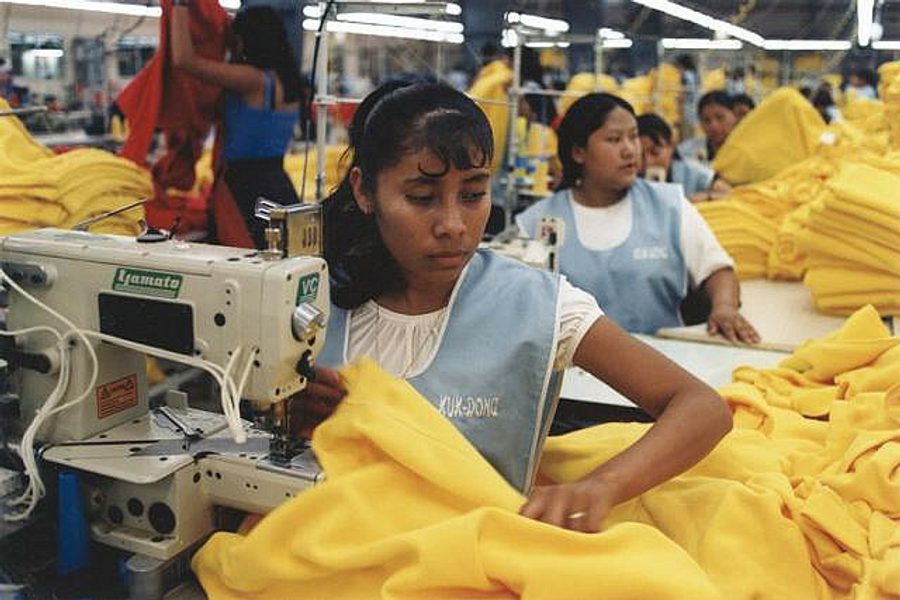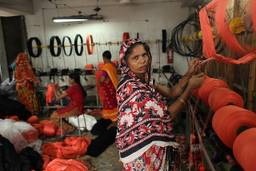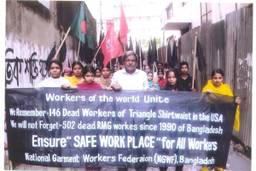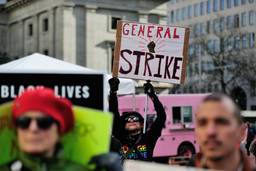In the Global Apparel Industry, Abusive and Deadly Working Conditions Are Still the Norm
Erik Loomis

Today, American citizens simply cannot know the working conditions of the factories that make the products they buy. We cannot know how the chemicals, tools, and technologies in these workplaces affect workers. Some brave workers publicize their conditions, and investigative institutions such as Human Rights Watch expose some of the worst violations, but there is an enormous knowledge gap.
This is hugely beneficial for corporations who want to keep us ignorant of their activities. We know about extreme incidents such as the Rana Plaza collapse that capture the world’s attention, however briefly, or when workers get so fed up with the conditions that they strike long enough and loud enough to get the Western world’s attention. But the day-to-day disasters that maim or kill a single worker or the accumulation of lead in workers’ bodies — those go almost completely unreported.
Much of that has taken place in the apparel industry, which has replicated Triangle-era conditions in sweatshops around the world. That it continues targeting women for this exploitative work is hardly surprising, as garment manufacturers did this in New England and the South in the twentieth century. Women need and want to work. For women in the developing world, work can be empowering, providing extra income, independence, or a way to escape an abusive relationship. Theoretically, American companies could provide this empowerment if they paid women a decent wage and employed them in clean factories that did not collapse or catch fire. But as geographer Melissa Wright has noted, employers see these women as “disposable,” workers to wring every ounce of profit from and then throw their “worthless” bodies out like garbage.
This attitude pervades the entire garment industry. It is hardly surprising then that many women choose the sex trade over the garment industry in nations like Cambodia. The pay is much better.
Some of the first industries to migrate to Mexico en masse after the Border Industrialization Program started were electronics and textiles — relatively low-skill and low-overhead industries find moving to flee regulations highly profitable. By 1994, 2,065 Mexican factories specifically opened using maquiladora legislation employed 579,519 people, nearly all in jobs migrated from the United States. Mexico was only the tip of the iceberg, and by the 1990s the geography of production extended into Central America and through Southeast Asia. This made American companies tremendous amounts of money. In 1993, the cost of labor in Malaysia was 10 percent of that in the United States, and in China it was only 3 percent.
In 1970, about one thousand women engaged in textile manufacturing in Malaysia. A decade later, eighty thousand women worked in textile, food processing, and electronics factories. A 1983 study of maquiladora workers in Ciudad Juárez, Mexico, showed an overwhelming young, single and female workforce. Eighty-five percent of the maquiladora workers were female. Electronics workers averaged only 20 years of age. American companies and Mexican maquiladora owners chose women for their supposed physical advantages, but really they chose them because they were paid less and were supposedly easy to control.
One Juárez electronics plant manager, referring to women as “patient” and “highly productive,” said, “In all cultures,” women “have the greater manual dexterity … This is why we prefer to use female workers in our plants.” This low-wage labor did not lead to improved income equality for women workers. In Mexico in 1980, women made 80 percent of men’s wages. Twelve years later, that had fallen to 57 percent. With women seen as disposable, plant managers do nothing to protect them from unsafe working conditions. The women soldering in electronics plants routinely burn their hands. The bad light of the factories causes their sight to diminish, while the acids and solvents workers use poison their bodies.
Women make up the vast majority of the workforce, but men make up the supervisors. Sexual harassment is endemic. A 2006 report by Mexican labor and feminist organizations detailed massive sexual harassment in maquiladoras. Labor authorities ignore or downplay this harassment, not wanting to anger the corporations who could move again at a moment’s notice. A Human Rights Watch survey from 2002 found widespread unreported sexual harassment and intimidation at Guatemalan maquiladoras, where women made up 80 percent of the eighty thousand workers. Forty-six percent of these factory workers had experienced mistreatment from their boss, and five percent had been subjected to sexual advances. Analysts consider these numbers underestimates, arguing that many women naturalize sexual harassment and refuse to report it or admit that it is happening to them.
Employers also discriminate against pregnant women. This has a long history: RCA fired pregnant electronics workers in its Bloomington, Indiana, plant in the 1940s. Preemployment pregnancy examinations are common today, as contractors do not want to give pregnant workers paid leave. Kimberly Estrada, a worker at a Dong Bang Fashions factory in Chimaltenango, reported that she had to undergo a gynecological exam by a company doctor at the factory before she could work. If workers became pregnant while employed, their bosses would not give them time off to go to the doctor nor the maternity leave mandated by the Guatemalan labor code. Women have miscarried at work, unable to get the medical treatment they needed to save their babies.
Human rights groups in the United States and Mexico filed a complaint in 1997 over what they called “state-tolerated sex discrimination against prospective and actual female workers in the maquiladora sector along the U.S.-Mexico border,” focusing on pregnancy testing and discrimination against pregnant workers. This pressure led to American companies announcing the end of pregnancy testing in the maquiladoras and Mexico issuing new directives to labor officials to stop it. Members of Congress introduced legislation to make pregnancy testing in American-owned factories illegal, suggesting that in fact American politicians could do much more to regulate the conditions of work overseas than they usually claim. But the textile companies found Mexican wages too high anyway, and they simply moved the jobs to Central America and Southeast Asia, forcing the struggle to start anew.
Low wages, sexual harassment, and poor working conditions continue to plague women in the garment industry. Today, women in Bangladesh toil in apparel factories for the national minimum wage of $37 a month. In one factory, women were forced to work 100 hours a week during peak production periods, and supervisors punched and slapped them. The victims included pregnant women, and at least one miscarried because of the treatment. Other pregnant women were forced to quit or denied their legally mandated maternity leave. Women in Cambodia and Indonesia fare little better, making $75 a month in the former and as low as $80 a month in the latter. In all these countries, women are fighting back through labor unions. In Indonesia, Nike had to pay 4,500 workers a $1 million settlement after having not paid them for more than 600,000 hours of overtime over a two-year period — a decision that came only after Indonesia’s labor federation pressed a lawsuit.
Unfortunately, the U.S. government contributes to these problems through its purchasing practices. The U.S. Marine Corps contracts its shirt production with DK Knitwear in Bangladesh. A 2010 report showed that one-third of DK workers were children, mostly young girls, and that the plant had no fire alarms despite previous fires in the facility. Women at Zongtex Garment Manufacturing in Cambodia soiled themselves at machines making clothes for the U.S. Army and Air Force. The Transportation Security Administration (TSA) signed a contract with a Mexican company in February 2013; the same company had previously treated uniforms with chemicals that caused rashes in TSA agents. Yet Republicans attacked TSA for paying too much to the Mexican workers. Like the rest of the apparel industry, the government relies on subcontractors, pays no attention to the working conditions in plants, and pushes for the cheapest price regardless of the social cost.
These clothing factories often expose workers to dangers that we can barely comprehend. Distressed jeans can sell for well over $100. But how do they become distressed? Chinese workers manually sandblast the jeans.
The fine silica dust of the sand used to treat distressed jeans is particularly dangerous. Silicosis has a long history in industrial labor. It was an epidemic for early twentieth-century American tunnel workers and those who worked in factories with fine rock particles in the air. Workers lost lung capacity and died, most notoriously up to 1,000 African Americans who blasted the Hawk’s Nest Tunnel near Gauley Bridge, West Virginia, in 1930 without even masks to protect them. Regulations in the United States cut down on the silicosis epidemic, but overseas employers re-create the deadly conditions of a century ago.
Outsourced garment factories have had a problem with silicosis for a long time. Since Turkey outlawed manually sandblasting jeans in 2009, companies such as Levi Strauss & Co. and Lee have claimed they have or will stop the practice. But as sick Chinese workers will tell you, it still happens, and they pay the price. A worker in a Guangdong factory said there was so much sand and dust in the air that he could not see the exit door. The suppliers do not provide workers with basic protections such as eyewear, facemasks, and gloves. There is no good reason for workers to contract silicosis today: its occurrence is only because of a system that combines profit-seeking Western companies with corrupt or indifferent governments in poor countries. Once again, because the jeans companies have outsourced production, they claim no responsibility for the problem.
Around one-third of textile workers in India suffer from respiratory diseases contracted at work. When you buy a piece of clothing that is “wrinkle free” or “stain resistant,” that is probably because formaldehyde is embedded in the fabric. Who put that formaldehyde there, inhaling the poison? Guatemalan activist Flor De María Salguero says of these factories, “There are some 14-year-old workers that work over ten hours a day. … There have been many accidents and injuries in the factories too — they use toxic chemicals that have burned some workers and are responsible for health problems and illnesses like cancer.”
Even if contractors want to treat their workers well, they often have little power to do so because cost is the only concern of the multinational corporations that place the contracts. When political scientist Mark Anner visited an apparel factory in El Salvador, he met a woman who had a contract to manufacture dresses for Kmart. The company forced her to limit costs to $1 per dress. When El Salvador raised the minimum wage, she could not pay the workers for the dress price. She asked Kmart to allow her a bit of leeway to pay the workers. The company refused, so she had no choice but to force workers to increase their daily productivity. In this arrangement, the American companies hold almost all the power. They could make life better for workers. They choose not to do so.
While the textile industry has received the most public attention for the outsourcing of terrible working conditions, it is hardly alone in this process. Conditions in electronics factories are no better. American, Japanese, and European companies have exported dangerous working environments to overseas plants. Hu Fengchao spray-painted DVD cases at a Panasonic plant in Dalian, China. He was exposed to toxic chemicals such as benzene, toluene, and xylene. He fell ill soon after starting work, but his employers told him to keep working. Finally, at the age of 28, Hu was diagnosed with aplastic anemia. His platelet count was so low that he risked death from a hemorrhage. Panasonic could have insisted upon basic protections such as masks for workers. Instead, Hu received no protection during his three years in the factory.
Tanning leather was never a pleasant job. Early American cities tried to banish it to the edge of town due to its noxious smells. Then, tanning largely used wood and contributed to deforestation in nineteenth-century New York and New England. Today, chemicals have replaced wood. Bangladesh is a modern center of tanning, exporting leather to the United States and Europe and using chemicals manufactured in rich nations and exported for poor workers to use without protection. Machines break, crushing workers’ arms. The workers are exposed to chromium, formaldehyde, axocolorants and other chemicals.
A worker named Poribar quit the tanneries after four stomach operations necessitated by breathing in gases including sulfur dioxide and hydrogen sulfide. He told Human Rights Watch, “When the hides are raw there are many acids, lime, and sodium on them. When I touched them with my hands, my hands are affected. If there’s a small cut, it will become much worse. The owner didn’t give us any gloves. The same with masks — we were never given them. If we’d been given them we would use them.” The World Health Organization estimates that 90 percent of Bangladeshi tanning workers die before the age of 50. Neither the chemical companies nor companies buying the Bangladeshi leather takes any responsibility for these conditions.
The working conditions of outsourced labor finally came to the world’s attention on May 10, 1993, when the Kader toy factory near Bangkok, Thailand, caught fire, killing 188 workers and severely injuring more than 500. The largest workplace disaster in Thai history, the Kader fire should have demonstrated to the world the very real costs of outsourcing unsafe working conditions to the world’s poorest countries.
But very little changed after this horrifying tragedy. The factory manufactured toys, mostly stuffed animals and plastic dolls, for Hasbro, Tyco, Toys“R”Us, Mattel, and other toy companies that had closed their American factories. Most of the 3,000 Kader workers were young women, some using fake IDs to get around age restrictions on labor. Thai law provided minimum wage only for full-time workers. Thus Kader and other manufacturers rarely employed people as full-time laborers. Compulsory overtime frequently kept workers until midnight, or even 5:00 a.m. if a deadline approached. Workers had their pay docked if they did not meet production quotas. On the fourth floor of Kader, 800 workers toiled. On that floor were eight toilets.
The fire alarm did not work and the fire spread rapidly in a factory full of finished plastic products. Bosses ordered the downstairs fire exits locked in order to maintain more control over workers. Fleeing back upstairs, the workers flooded the upper fire exits, causing them to collapse under all the weight. Workers began jumping from the upper stories to escape the flames. Said one survivor, “I didn’t know what to do. Finally I had no other choice but to join others and jump out the window. I saw many of my friends lying dead on the ground beside me. I injured my legs but I came out alive.” Said another, “In desperation, I went back and forth looking down below. The smoke was so thick and I picked the best place to jump in a pile of boxes. My sister jumped too. She died.”
If this sounds much like the procession of events at Triangle, with young women dying in a burning sweatshop because of lax safety regulations and a system of widespread exploited labor, commenters at the time noted the same thing as well. In Thailand the main building collapsed from the heat of the fire. The building was constructed with uninsulated steel girders that collapsed after 15 minutes of intense heat. Shoddy design combined with employer malfeasance and a lack of basic safety standards to allow an easily preventable disaster. Prime Minister Chuan Leekpai traveled to the factory site on the night of the tragedy and pledged greater fire safety for Thai workers. But not one executive nor manager received even a day in jail. The management was fined $12,000 for building code violations. The toy companies, of course, took no responsibility.
American corporations made no meaningful reforms after the Kader fire. Today, temperatures inside Asian toy factories routinely reach 100 degrees Fahrenheit. In the 2000s, the toy industry again received attention in the United States when Chinese-made toys used lead paint. American parents were outraged. But this was strictly a consumer reaction; we seemed to care only about the health of our own children. What impact did these lead toys have on the workers? Largely, we do not know. This system results from Mattel and Fisher-Price simply not caring how their toys are produced so long as they come in under cost. Safety last.
This is an excerpt from Erik Loomis’s new book Out of Sight: The Long and Disturbing Story of Corporations Outsourcing Catastrophe, out now from the New Press.







